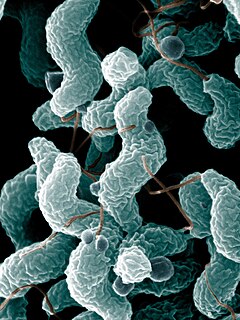
Campylobacterota are a phylum of bacteria. All species of this phylum are Gram-negative.
The Gemmatimonadota are a phylum of bacteria established in 2003. The phylum contains two classes Gemmatimonadetes and Longimicrobia.
Brevibacterium is a genus of bacteria of the order Micrococcales. They are Gram-positive soil organisms.
Streptomyces glycovorans is a bacterium species from the genus of Streptomyces which has been isolated from marine sediments of the South China Sea near the Xisha Islands in China.
Streptomyces xishensis is a bacterium species from the genus of Streptomyces which has been isolated from marine sediments from the South China Sea near the Xisha Islands in China.
Microbacterium hydrothermale is a Gram-positive, aerobic, rod-shaped and non-motile bacterium from the genus of Microbacterium which has been isolated from hydrothermal sediments from the Indian Ocean.
Desmospora profundinema is a bacterium from the genus of Desmospora which has been isolated from deep-sea sediments from the Indian Ocean near China.
Marininema halotolerans is a Gram-positive bacterium from the genus of Marininema which has been isolated from marine sediments from the Little Andaman Island from the Indian Ocean.
Melghirimyces profundicolus is a bacterium from the genus of Melghirimyces which has been isolated from deep-sea sediments from the Indian Ocean.
Prauserella is a Gram-positive, aerobic and non-motile genus from the family of Pseudonocardiaceae.
Confluentibacter is a genus from the family of Flavobacteriaceae.
Janibacter is a genus of Gram positive, nonmotile, non-sporeforming bacteria. The genus name is derived from the two-faced Roman god Janus, referring to the fact that the cells of the original strain could be rod-shaped or coccoid.
Gulosibacter is a Gram-positive, strictly aerobic, non-spore-forming and non-motile genus of bacteria from the family Microbacteriaceae.
Paraglaciecola arctica is a Gram-negative, psychrotolerant and motile bacterium from the genus of Paraglaciecola which has been isolated from sediments from the Arctic Ocean.
Virgibacillus oceani is a Gram-positive, moderately halophilic, endospore, rod-shaped-forming, strictly aerobic and motile bacterium from the genus of Virgibacillus which has been isolated from sediments from the Pacific Ocean.
Janibacter limosus is a species of Gram positive, strictly aerobic, bacterium. The species was initially isolated from sludge from a wastewater treatment plant in Jena, Germany. The species was first described in 1997, and the species name is derived from Latin limosus (muddy). J. limosus was the first species assigned to Janibacter, and is the type species for the genus.
Janibacter indicus is a species of Gram positive, aerobic, bacterium. The species was initially isolated from hydrothermal sediment from the Indian Ocean. The species was first described in 2014, and the species named refers to the Indian Ocean.
Janibacter melonis is a species of Gram positive, aerobic, bacterium. The species was initially isolated from an abnormally spoiled oriental melon. The species was first described in 2004, and the species name refers to the melon from which it was first isolated.
Prolixibacteraceae is a family of 11 bacterial genera in the order of Bacteroidales.
Anaeromicrobium is an anaerobic, mesophilic and heterotrophic bacterial genus from the family of Clostridiaceae, with one known species. Anaeromicrobium sediminis has been isolated from deep-sea sediments from the West Pacific Ocean.
